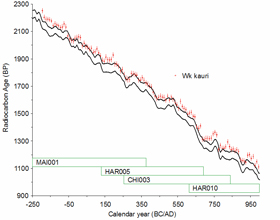Radiocarbon calibration

14C measurements from dendrochronologically-dated New Zealand kauri; overlain by the Northern hemisphere calibration curve (IntCal09).
Radiocarbon dating is the most widely used tool for helping to define geological, palaeoenvironmental and archaeological events that have shaped the last 60,000 years. However, atmospheric 14C concentration has varied through time due to cosmic ray fluctuations. This means that 14C dates do not equate directly with calendar time and must be corrected using a calibration curve (constructed by 14C dating of samples of known calendar age, such as tree rings).
The Waikato Radiocarbon laboratory was instrumental in the development of the Southern Hemisphere terrestrial calibration curve (SHCal20) and the Northern Hemisphere terrestrial curve (IntCal20).
The papers describing the use of these curves are published in Radiocarbon: SHCal20 and IntCal20.